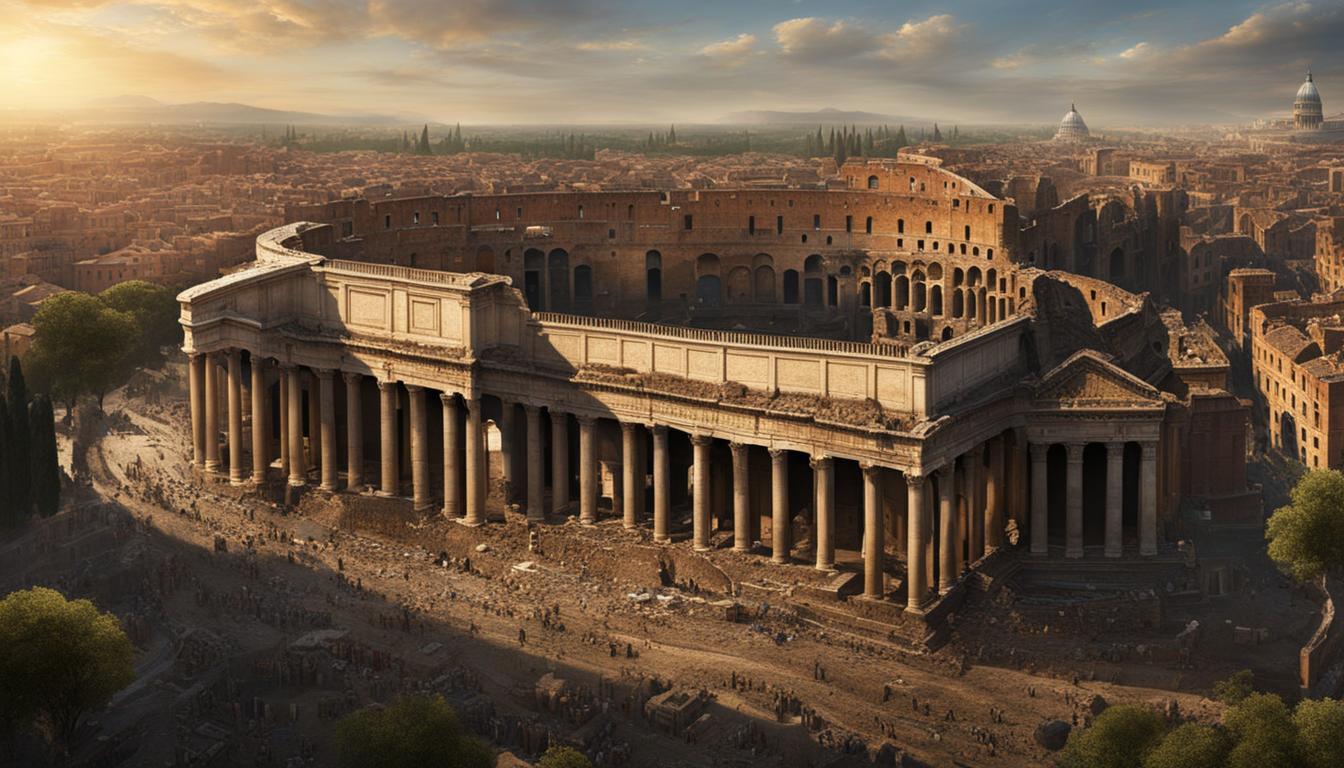Ancient Rome, the seat of Western civilization, is a city that exudes power, politics, and pagan gods. It is a testament to enduring feats of engineering and grandeur. With a rich history and significant contributions to art, architecture, and culture, ancient Rome continues to captivate visitors today.

Key Takeaways
- Ancient Rome is a city that showcases power, politics, and pagan gods.
- Ancient Rome has a rich history and significant contributions to art, architecture, and culture.
- Exploring ancient Rome offers a glimpse into enduring feats of engineering and grandeur.
- Ancient Rome continues to captivate visitors today with its captivating history and cultural heritage.
- Visiting ancient Rome is a journey through time and a chance to appreciate the Roman civilization.
Unveiling the Majesty of the Colosseum
The Colosseum, an iconic symbol of ancient Rome, reveals the awe-inspiring grandeur of Roman architecture and engineering prowess. This monumental amphitheater, also known as the Flavian Amphitheatre, was constructed between 70 and 80 AD, and it still stands as a testament to the ingenuity of the Roman Empire.
With a capacity to hold up to 50,000 spectators, the Colosseum was the largest amphitheater ever built. It was primarily used for gladiatorial contests, where skilled fighters would battle for their lives in front of a roaring crowd. Animal hunts and other spectacular shows were also hosted here, making it a center of entertainment and excitement.
The Colosseum is a marvel of architectural design and engineering. Its elliptical shape and multiple levels were carefully crafted to ensure unobstructed views for all spectators. The outer facade of the Colosseum showcases a fusion of Doric, Ionian, and Corinthian architectural styles, reflecting the eclectic tastes of the time.
Step inside the Colosseum, and you’ll be transported back in time to the glory days of ancient Rome. Feel the energy of the crowd that once cheered on gladiators in epic battles. Marvel at the skill and precision of the architects who brought this magnificent structure to life.
The Colosseum not only exemplifies Roman architectural brilliance but also serves as a reminder of the immense power and influence of the Roman Empire. Its imposing presence continues to captivate visitors from around the world, drawing them into the fascinating world of ancient Rome.
Interesting Facts about the Colosseum:
- The Colosseum was originally called the Flavian Amphitheatre after the Flavian dynasty of emperors who commissioned its construction.
- It took approximately 8 years to complete the Colosseum, with thousands of workers involved in its construction.
- The Colosseum’s underground chambers housed gladiators, wild animals, and staging equipment for the elaborate shows.
- The retractable awning, known as the velarium, provided shade for spectators on hot summer days.
- Over the centuries, the Colosseum suffered damage due to earthquakes and stone looting, but it still stands as a remarkable testament to Roman engineering and architecture.
| Dimensions | Facts |
|---|---|
| Diameter | 188 meters |
| Height | 48 meters |
| Number of Arches | 80 |
| Stories | 4 |
| Material | Concrete and stone |
Tracing the Footsteps of Roman Rulers
Step back in time and delve into the captivating history of ancient Rome, led by legendary rulers and influential figures who shaped the destiny of this mighty civilization. From the iconic Julius Caesar to a long line of Roman emperors, their impact on Roman history and culture is undeniable.
Julius Caesar, one of the most renowned Roman leaders, played a pivotal role in the transition from the Roman Republic to the Roman Empire. Through his military conquests and political reforms, he laid the foundations for a new era of Roman governance. Caesar’s legacy resonates in our modern society, with his name still evoking intrigue and admiration.
After Caesar’s assassination, a succession of emperors took the reins of power, each leaving their mark on Roman history. Emperor Augustus, Caesar’s adopted son, ushered in a period known as the Pax Romana, characterized by relative peace, stability, and administrative reforms. His rule brought about significant changes in governance and the consolidation of the Roman Empire.
Other notable emperors, such as Trajan, Hadrian, and Marcus Aurelius, expanded the empire’s territorial reach, implemented infrastructure projects, and fostered cultural advancements. Their contributions can be seen in remarkable structures like Trajan’s Column, Hadrian’s Wall, and the Antonine Wall.
While some emperors left a positive imprint, others faced scrutiny and criticism for their tyrannical rule. Caligula, notorious for his extravagance and disregard for the Senate, remains a symbol of excess and abuse of power. Nero, known for his persecution of Christians and his role in the Great Fire of Rome, left a legacy tainted by infamy.
“The evil that men do lives after them;
The good is oft interred with their bones.”- Mark Antony in Shakespeare’s Julius Caesar
Exploring the lives and reigns of these fascinating rulers provides a deeper understanding of the complexities of ancient Rome. It allows us to appreciate the political, social, and cultural dynamics that propelled this empire to great heights.
Continue your journey through Roman history as we uncover more secrets of this extraordinary civilization.
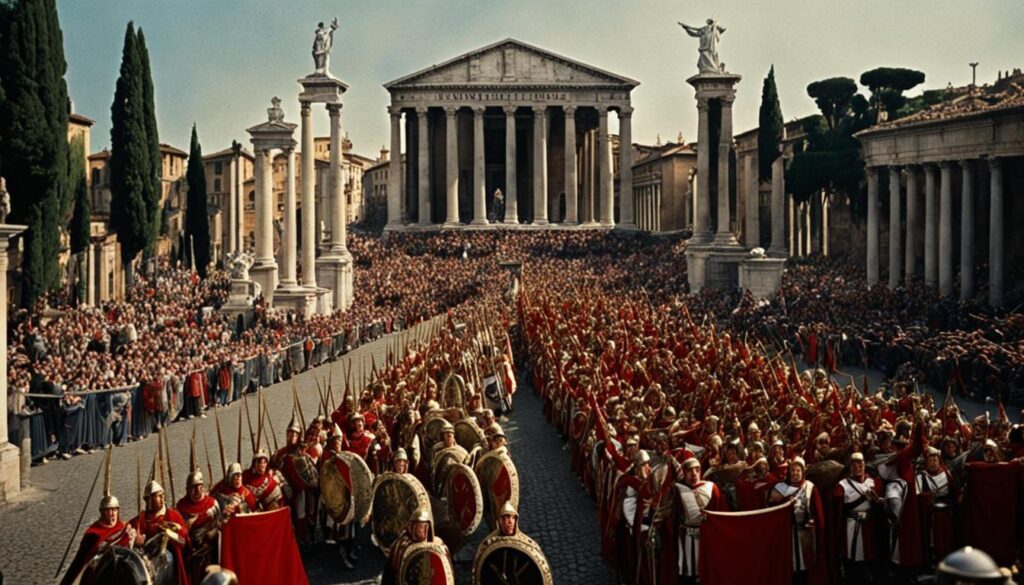
Unearthing the Roman Forum
The Roman Forum, known as the birthplace and civic center of ancient Rome, is a historical site of immense importance. It served as a place for political, religious, and commercial activities. Exploring the ruins of the Forum offers a glimpse into the daily life and achievements of the Roman civilization.
The Roman Forum, also known as the Forum Romanum, was the heart of ancient Rome. It was originally a marketplace and eventually became the epicenter of Roman political, social, and religious life. Home to numerous statues, temples, and basilicas, the Forum was a bustling hub where citizens gathered to conduct business, worship their gods, and engage in public affairs. Walking through the ancient ruins, you can almost feel the echoes of the past and imagine the vibrant atmosphere that once filled these hallowed grounds.
The Roman Forum played a pivotal role in shaping the Roman civilization and leaving a lasting impact on Western history. It was here that famous speeches were delivered, laws were enacted, and monumental events took place. From Julius Caesar’s funeral procession to the triumphal processions of victorious generals, the Forum witnessed countless pivotal moments in Roman history.
Today, visitors can explore the remnants of this magnificent archaeological site and marvel at the architectural marvels that stand as a testament to the ingenuity of ancient Rome. Walking along the Via Sacra, the main road of the Forum, you can admire the ruins of the Temple of Saturn, the Curia Julia, and the iconic Arch of Septimius Severus. Each structure is a testament to the grandeur and sophistication of Roman engineering and architecture.
Key Features of the Roman Forum:
- The Temple of Saturn: Dedicated to the Roman god Saturn, the temple was the center of religious and political ceremonies.
- The Curia Julia: The meeting place of the Roman Senate, where important political decisions were made.
- The Arch of Septimius Severus: A triumphal arch dedicated to Emperor Septimius Severus and his sons.
- The Rostra: A platform from which speeches and public announcements were made.
Visiting the Roman Forum allows you to step back in time and immerse yourself in the rich history and culture of ancient Rome. It is a journey of discovery, where you can witness the remnants of a once-great civilization and gain a deeper understanding of its achievements and legacy.
| Highlights of the Roman Forum | Description |
|---|---|
| The Temple of Saturn | Ancient temple dedicated to the Roman god Saturn. It was the hub of religious and political activities. |
| The Curia Julia | The meeting place of the Roman Senate. It played a significant role in shaping Roman politics and governance. |
| The Arch of Septimius Severus | A magnificent triumphal arch dedicated to Emperor Septimius Severus and his sons. It commemorates their military victories. |
| The Rostra | A platform used for public speeches and announcements. It was a central gathering place for political discussions. |
Discovering the Architectural Marvels of Rome
Rome, known as the eternal city, is a treasure trove of architectural wonders that showcase the ingenuity and grandeur of ancient Rome. From the majestic Pantheon to the awe-inspiring Temple of Saturn and the magnificent Basilica Julia, the city’s structures stand as testaments to Roman architecture and the enduring legacy of the Roman civilization.
One of the most iconic landmarks of Rome is the Pantheon, a remarkable feat of engineering and design. Its impressive dome, adorned with a central oculus, has long been revered as a marvel of ancient engineering. Step inside the Pantheon and be captivated by its harmonious proportions and the interplay of light and shadows through the oculus.
In the heart of the Roman Forum lies the Temple of Saturn. Built in the 5th century BC, it served as a hub for political and religious activities. Although now in ruins, the surviving columns and pediment offer a glimpse into the splendor and significance of this revered temple.

| Name | Location | Description |
|---|---|---|
| Pantheon | Piazza della Rotonda | Ancient Roman temple with an iconic dome |
| Temple of Saturn | Roman Forum | Political and religious center of ancient Rome |
| Basilica Julia | Roman Forum | Ancient courthouse and meeting place |
Another architectural wonder to explore is the Basilica Julia, located in the Roman Forum. This ancient courthouse and meeting place once hosted legal proceedings, business transactions, and social gatherings. Immerse yourself in the history of this monumental structure as you wander through its remains.
“Roman architecture is a testament to human creativity and innovation. The architectural marvels of Rome continue to inspire awe and fascination, showcasing the greatness of the ancient Roman civilization.”
Each architectural masterpiece in Rome holds a story of Roman civilization and its enduring influence. From the intricate details of marble columns to the magnificent arches and vaults, these structures offer a glimpse into the past and the remarkable achievements of ancient Rome.
As you explore the architectural marvels of Rome, let the sprawling city transport you back in time and immerse yourself in the beauty and grandeur of the Roman civilization.
Exploring the Capitoline Museum
The Capitoline Museum, established in 1471, is one of the world’s oldest museums. It houses a collection of ancient Roman sculptures and artifacts, offering visitors an opportunity to delve into the artistic and cultural heritage of Rome. From iconic statues like the She-Wolf to the marble Dying Gaul, the museum showcases the masterpieces that shaped Roman art.
As you wander through the museum’s halls, you’ll be captivated by the exquisite craftsmanship of these ancient works. The Capitoline Venus, a renowned marble sculpture, epitomizes the beauty and grace of Roman art. Its delicate features and lifelike portrayal make it a timeless masterpiece.
Not only does the museum house exceptional sculptures, but it also displays a variety of ancient artifacts that provide insights into Roman civilization. Fascinating exhibits include ancient coins, pottery, and jewelry, each telling a unique story about life in ancient Rome.
One of the highlights of the Capitoline Museum is the Tabularium, an ancient Roman archive. This space offers breathtaking panoramic views of the Roman Forum, allowing you to appreciate the historical context of the museum’s collection and the grandeur of the surrounding ancient ruins.
“The Capitoline Museum is a treasure trove of Roman art and civilization. Its collection reflects the skill and creativity of ancient Roman artists, capturing the essence of a bygone era.”
Journey through Roman Art
Embark on an enchanting journey through Roman art as you explore the various galleries of the Capitoline Museum. Admire the statues of Roman gods and goddesses, marvel at intricate mosaics, and learn about the significance of ancient Roman mythology.
| Gallery | Highlights |
|---|---|
| The Hall of Emperors | Discover lifelike busts and statues of Roman emperors, including Augustus and Trajan. |
| The Juno Room | Be captivated by the majestic statue of Juno, the queen of the gods, and explore the mythology surrounding her. |
| The Hall of the Philosophers | Delve into the intellectual world of ancient Rome as you encounter statues and sculptures representing renowned philosophers such as Seneca and Socrates. |
Whether you’re an art enthusiast or simply intrigued by Roman civilization, the Capitoline Museum offers an enriching and immersive experience. Immerse yourself in the world of ancient Rome as you admire the masterpieces that have shaped our understanding of Roman art and culture.
Uncovering the Secrets of the Palatine Hill
The Palatine Hill, overlooking the Roman Forum, is an archaeological site that holds the remains of the ancient Imperial Palace. As you explore this historic hill, you’ll be transported back in time to the opulent lifestyle of Roman emperors and the greatness of Rome itself.
Once the center of power in the Roman Empire, the Palatine Hill offers a fascinating glimpse into Roman history and civilization. Here, you can walk amidst the ruins and imagine the grandeur of the imperial palaces that once stood proudly on this hill.
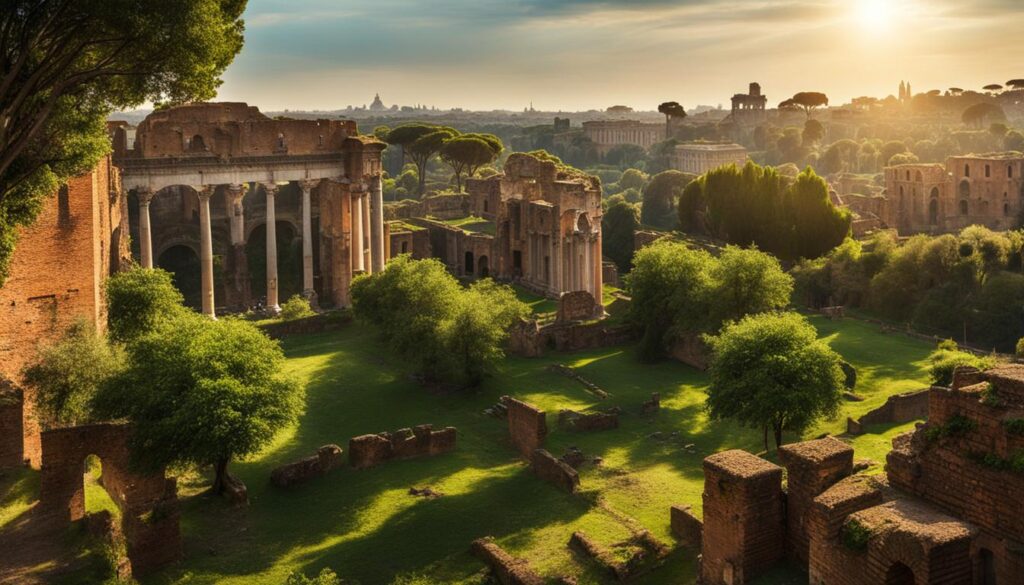
The Palatine Museum, located on the hill, is a treasure trove of statues and frescoes that help recreate the splendor of the ancient Roman world. It houses artifacts that provide insights into the lives of emperors, their courtiers, and the society they governed. These stunning works of art tell stories of power, luxury, and the Roman way of life.
“The Palatine Hill offers a unique opportunity to step into the shoes of ancient Roman emperors and witness the magnificence of Rome’s golden age.” – Roman historian
As you wander through the Palatine Hill, you’ll encounter fascinating ruins such as the Domus Augustana, the House of Livia, and the Stadium of Domitian. Each holds its own secrets and stories, waiting to be uncovered by curious visitors like yourself.
Roman Emperors Who Resided on the Palatine Hill
| Emperor | Reign |
|---|---|
| Augustus | 27 BC – 14 AD |
| Tiberius | 14 AD – 37 AD |
| Nero | 54 AD – 68 AD |
| Domitian | 81 AD – 96 AD |
Visiting the Palatine Hill is an unforgettable journey through Roman history. It allows you to immerse yourself in the ancient world, witness the legacy of Roman civilization, and gain a deeper understanding of the greatness that was Rome.
Immersing in the National Museum of Rome
When it comes to exploring the rich history and artistic heritage of ancient Rome, the National Museum of Rome is a treasure trove of captivating artifacts and masterpieces. With its extensive collection of Roman art and sculptures, this museum offers a unique opportunity to immerse yourself in the grandeur of ancient Rome.
As soon as you step through the museum’s doors, you’ll be transported back in time to the days of the mighty Roman Empire. The museum showcases a wide range of ancient Roman artifacts, from intricate mosaics and frescoes to awe-inspiring marble sculptures.
One of the highlights of the National Museum of Rome is its remarkable collection of dramatic portraits. These lifelike depictions of emperors, nobility, and influential citizens captivate visitors with their intricate details and striking realism. Each portrait tells a story of power, prestige, and the artistic prowess of the ancient Romans.
A Glimpse into Roman History and Culture
Visiting the National Museum of Rome offers a unique opportunity to delve into the captivating history of ancient Rome. From the rise and fall of emperors to the influential role of Christianity, the museum provides a comprehensive look at the cultural, social, and political aspects of Roman civilization.
“The National Museum of Rome is an immersive journey into the heart of ancient Rome’s rich artistic and cultural legacy. It allows visitors to witness firsthand the incredible craftsmanship and creative brilliance that defined the Roman Empire.” – Art Historian
One cannot miss the magnificence of Roman sculpture on display at the museum. The intricate carvings, the attention to detail, and the sheer beauty of these ancient artworks are a testament to the skill and vision of Roman artisans.
The National Museum of Rome also sheds light on the impact of Christianity on the Roman Empire. Here, you can explore the transition from pagan beliefs to the rise of Christianity through artifacts and exhibits. Witness the transformation of Rome and its culture as Christianity gained prominence.
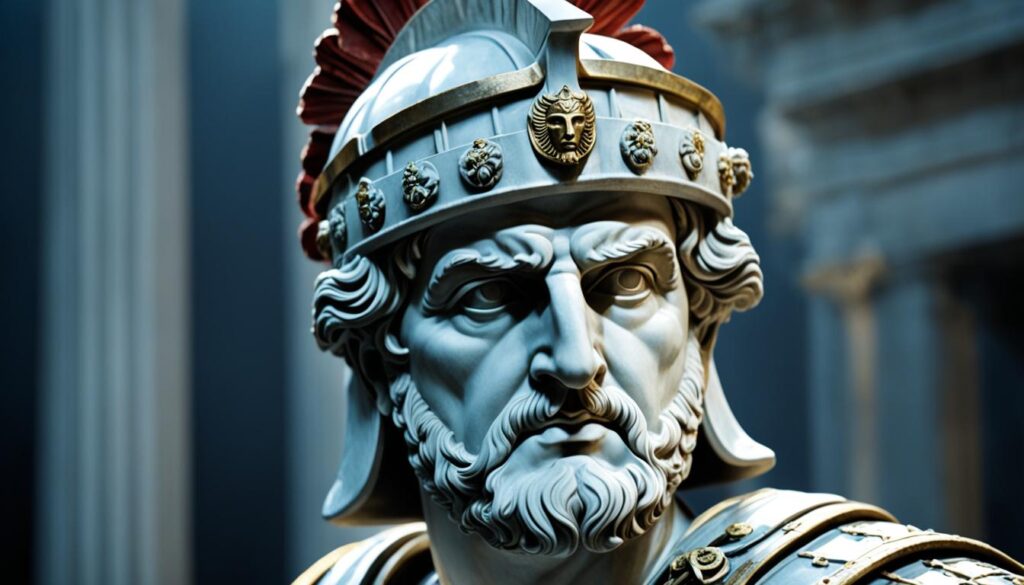
| Section | Exhibits |
|---|---|
| Ancient Sculptures | A collection of breathtaking marble statues, including famous works such as “The Dying Gaul” and “Capitoline Venus”. |
| Frescoes and Mosaics | Immerse yourself in the vivid colors and intricate designs of ancient Roman frescoes and mosaics. |
| Portraits of Power | Discover the iconic and hauntingly realistic portraits of Roman emperors and influential figures. |
| Christian Artifacts | Explore the transition from paganism to Christianity through ancient artifacts and religious objects. |
Whether you’re a history enthusiast, an art lover, or simply curious about the wonders of ancient Rome, a visit to the National Museum of Rome is a must. Immerse yourself in the awe-inspiring beauty of Roman art and gain a deeper understanding of the rich cultural heritage that left an indelible mark on the world.
Marveling at the Pantheon’s Architectural Brilliance
The Pantheon, with its iconic dome, stands as a testament to the architectural brilliance of ancient Rome. Built over two thousand years ago, it still mesmerizes visitors with its grandeur and mathematical precision. Standing beneath the dome, you can appreciate the sophistication and engineering skills of the ancient Romans.

The Pantheon is a true marvel of roman architecture. Its domed structure, made of concrete and topped with a circular oculus, showcases the Romans’ mastery of architectural design. The oculus, which is open to the sky, allows natural light to illuminate the interior of the Pantheon, creating a breathtaking play of light and shadow. The immense weight of the dome is ingeniously distributed through decorative coffers, reducing the stress on the structure and contributing to its longevity.
Once inside, you’ll be captivated by the sheer scale and beauty of the Pantheon. The vast open space and the intricate details of the marble columns and floor are a sight to behold. It is a true testament to the grandeur and magnificence of ancient Rome.
“The Pantheon is a shining example of Roman architecture, showcasing their innovative techniques and dedication to creating monumental and awe-inspiring structures.”
As you explore the interior, your gaze will be drawn to the oculus, a remarkable feat of engineering. The precise positioning of the oculus allows for a beam of light to focus on different parts of the Rotunda throughout the day, creating a fascinating interplay between light and space.
The Beauty of the Pantheon’s Dome
The dome of the Pantheon is a remarkable architectural achievement. Its design and construction have stood the test of time, inspiring generations of architects and engineers. The dome’s dimensions and composition showcase the Romans’ deep understanding of geometry and materials.
With a diameter of 43.3 meters, the Pantheon’s dome was the largest unreinforced concrete dome in the world until modern times. The base of the dome is thick, gradually thinning towards the oculus, which serves as the central focal point both aesthetically and structurally. The mathematically precise design ensures that the weight of the dome is distributed evenly, allowing it to withstand the test of time.
Visiting the Pantheon
If you’re planning a trip to Rome, a visit to the Pantheon is a must. Take a moment to marvel at the architectural brilliance as you stand inside this ancient wonder. Experience the awe-inspiring atmosphere and contemplate the ingenuity of the ancient Romans.
As you explore the Pantheon, be sure to take a moment to appreciate the intricate details of the interior, from the marble floor to the beautiful Corinthian columns. Feel the weight of history and immerse yourself in the timeless beauty of the Pantheon.
Cycling Along the Ancient Appian Way
Embark on a remarkable cycling journey along the historic Appian Way, also known as the Queen of Roads. This ancient route, connecting Rome with Capua, offers a unique opportunity to immerse yourself in the glory of ancient Rome and witness the incredible achievements of Roman engineering. As you pedal along the original pavement stones, you’ll be transported back in time, surrounded by breathtaking sights that reflect the grandeur and magnificence of the Roman Empire.
With every push of the pedal, you’ll experience the awe-inspiring ingenuity of Roman engineering that made this road possible. Marvel at the sophisticated construction techniques employed by the ancient Romans, who crafted this monumental thoroughfare to withstand the test of time. The Appian Way stands as a testament to the engineering brilliance of the Roman civilization, showcasing their mastery in creating lasting infrastructure.
As you cycle along, you’ll be captivated by the various sights that line this ancient road, each offering a glimpse into the greatness of Rome. Pass by ancient tombs, iconic monuments, and archaeological sites that bear witness to the rich history and cultural heritage of ancient Rome. From the majestic Tomb of Caecilia Metella to the captivating ruins of Villa di Massenzio, every stop along the Appian Way reveals a fascinating chapter in the story of ancient Rome.
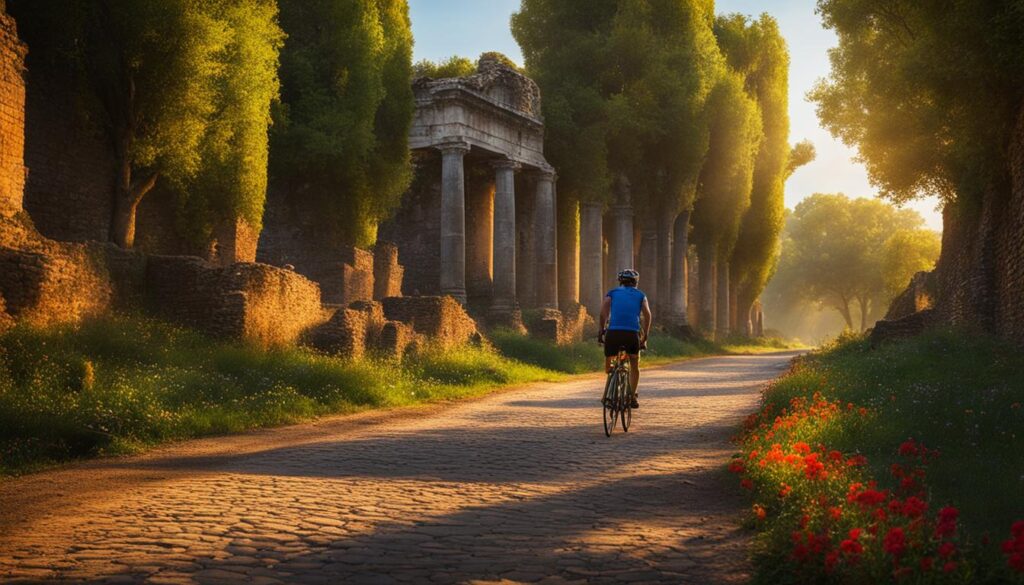
Immerse yourself in the picturesque landscapes that envelop the Appian Way. Feel the gentle breeze as you pedal through the lush countryside, surrounded by rolling hills, cypress trees, and quaint Roman villas. This cycling adventure offers not only a physical journey but also a spiritual connection to the past, allowing you to appreciate the beauty and significance of this ancient road in its entirety.
“Cycling along the Appian Way was like stepping into a time machine. The combination of stunning scenery and the palpable history was truly awe-inspiring. It’s an experience that every travel enthusiast should have.”
– Jessica Thompson, avid cyclist and ancient history aficionado
Whether you’re a history enthusiast, a cycling aficionado, or simply someone seeking a unique adventure, exploring the Appian Way is an experience that will leave an indelible mark on your journey through ancient Rome. Get ready to embark on an unforgettable expedition that intertwines the past and the present, revealing the remarkable legacy of Roman engineering and the enduring splendor of ancient Rome.
Experiencing the Essence of Ancient Rome in the Catacombs of San Sebastiano
Delve into the early Christian era and the burial practices of ancient Rome by exploring the Catacombs of San Sebastiano. These underground tunnels provide a fascinating glimpse into a time when Christianity was beginning to emerge as a prominent religion in the Roman Empire.
The Catacombs of San Sebastiano are adorned with faded frescoes and graffiti that reflect the religious beliefs and practices of the time. As you navigate through the narrow passages, you’ll encounter intricate artwork depicting biblical scenes, symbols of faith, and portraits of early Christian saints.
Visiting the catacombs allows you to witness firsthand the intertwining of Christianity and ancient Roman culture. It offers a unique opportunity to understand the challenges faced by early Christians and how they sought solace and community in these sacred underground chambers.
“The Catacombs of San Sebastiano provide a tangible connection to the early days of Christianity. Walking through these ancient tunnels, adorned with religious symbols and artwork, instills a sense of awe and reverence for the faith that has shaped our world.” – Roman History Enthusiast
Descend deep into history and immerse yourself in the spiritual atmosphere of the Catacombs of San Sebastiano. Experience the mysterious allure of this archaeological site, where the ancient echoes of early Christianity and the vibrant legacy of ancient Rome converge.
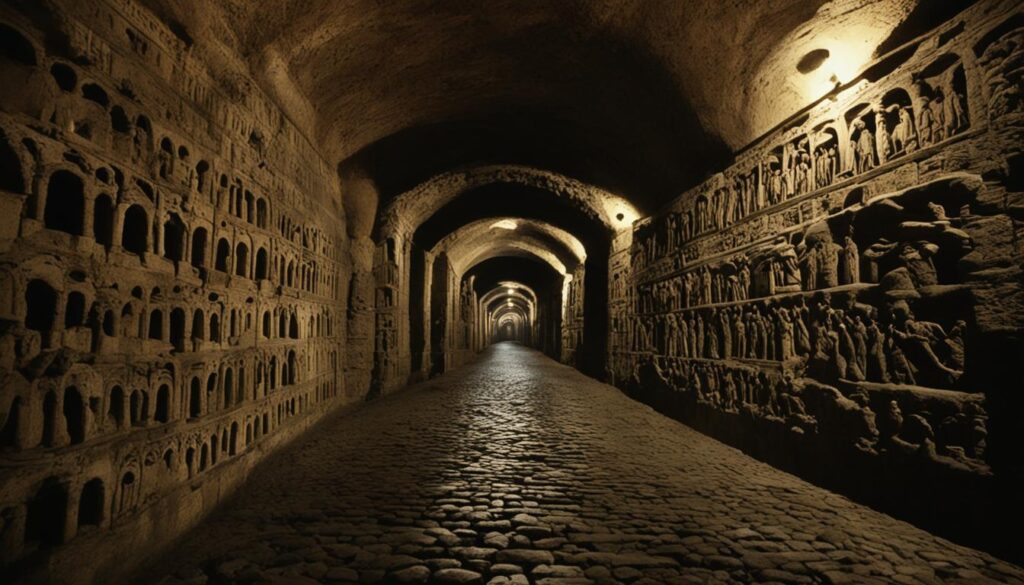
Discover more about Rome’s fascinating history in the following sections.
Conclusion
Ancient Rome, with its rich history, architectural wonders, and cultural heritage, continues to captivate modern-day visitors. From the grandeur of the Colosseum to the ruins of the Roman Forum, exploring the glory of ancient Rome is an awe-inspiring experience. It is a journey through time that allows you to immerse yourself in the enduring legacy of this once-mighty civilization.
Stepping into the Colosseum, you can almost hear the echoes of gladiator contests and experience the thrill of the ancient spectacles that once filled its grounds. The magnitude of this monumental amphitheater is a testament to the architectural genius of the Roman civilization.
The Roman Forum, the political and commercial heart of ancient Rome, presents a fascinating glimpse into daily life and the achievements of the Roman civilization. Walking through its ruins, you can imagine the debates and ceremonies that took place at this bustling center of Roman power.
Ancient Rome’s impact on art, architecture, and culture is undeniable. The masterpieces housed in the Capitoline Museum and the National Museum of Rome offer a chance to delve into the artistic and cultural heritage of the city. From sculptures to frescoes, the skilled craftsmanship of ancient Rome is on full display.
